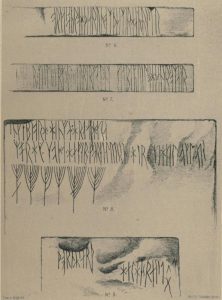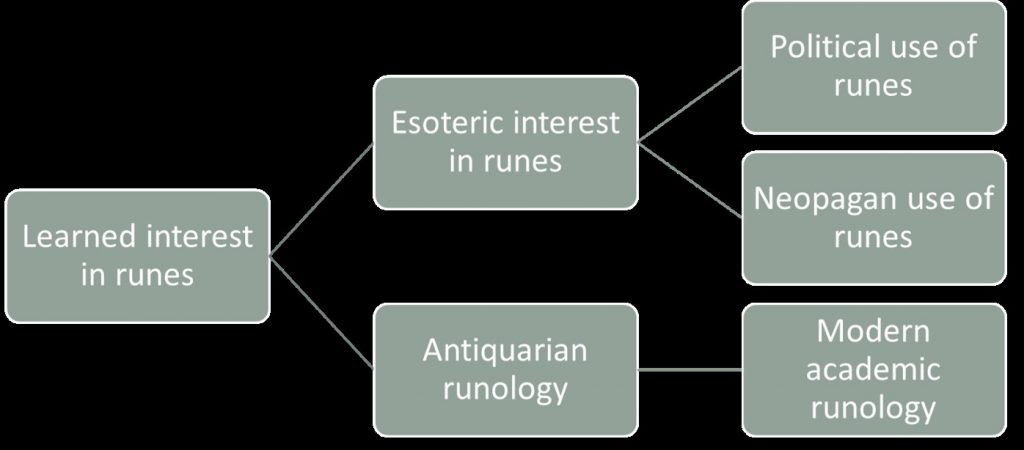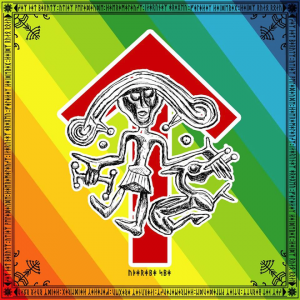Andrea Freund, Institute for Northern Studies, Orkney College, UHI
I am currently doing a PhD in runology, the study of runes. However, it is difficult to study a field that has become so public in a time where everybody can be an expert and yet, some of the loudest voices in the public dialogue can declare that entire countries are “sick” of experts. Where does that leave runologists in the 21st century?
To understand modern runology and its challenges, it is essential to look at the history of using runes. After runes had fallen out of use as an everyday writing system in the Scandinavian diaspora and most of Scandinavia except for some remote valleys, learned interest in runes began in the late 16th and early 17th century with Johannes Bureus who attempted in 1611 to reintroduce them as a common writing system in Sweden (Barnes 2012: 133 – 135). In the following period, when Sweden had lost a large part of its earlier Empire, the Vikings were re-discovered and interpreted as glorious ancestors (Molin 2003: 269 – 274; Geisler 2007: 26 – 28). Similar developments happened in Denmark and somewhat later in Norway, too. This even led to polemic arguments between Danish and Swedish scholars in the 17th century about who had invented the runes (Barnes 2012: 194). From the 17th century on, antiquarians recorded the Scandinavian runestones and tried to make sense of their inscriptions. The discovery of 33 inscriptions in the Neolithic tomb of Maeshowe, Orkney, resulting in their interpretation by three of the foremost Norse scholars of their time and subsequent publication in 1862, counts as a milestone in the development of runology as an academic discipline (Farrer 1862).

However, antiquarians were not the only ones with an interest in runes in the 19th century. In Germany in the 19th century, for the first time a national conscience arose leading to the so-called Völkische Bewegung. In order to strengthen the sense of German-ness, a national narrative, mythology and symbolism were necessary and these were found in the Vikings, extending to their writing system, namely runes (Schulz 2009: 8-11). The ideological backbone for this movement was delivered by scholars like Gustaf Kossina and Karl Müllenhoff who claimed that Viking mythology could provide clues to true German-ness. They strongly opposed the previously prevalent ex oriente-view and instead focused on promoting a heroic Germanic past. As “proof” they even compiled a Germanic counterpart for the bible, a Germanenbibel, containing parts of the Eddas (Mees 2006: 184-188, Puschner 2001: 92 – 93).
During the National Socialist regime in Germany, the mixture of academic Viking research and racist ideologies intensified. This is exemplary in the persona of Wolfgang Krause, from 1938 director of the library for Nordic Philology at Göttingen university. He was also head of the Zentralstelle für Runenforschung des Ahnenerbe e.V., which constituted a sub-division of the SS, directly subordinated to Heinrich Himmler, and was supposed to deliver a scientific justification for the worldwide dominance of “Aryan” Germans.
In this period, many volumes on Old Norse and Runology were robbed from their original owners by the SS and delivered to the Zentralstelle für Runenforschung (Möbus 2011: 89 – 90). Politically, there was a strong desire to “prove” that runes were the original human writing system, which again was supposed to show that Germanic people had invented writing in connection with an Odinic cult. However, even at the time academics argued against the view that runes were older than the Egyptian hieroglyphs and there was considerable debate on the origin of runic writing, both in Germany and internationally (Philippson 1938: 322 – 326). In Norway, nationalists from the periphery of the national socialist party Nasjonal Samling established various groups before and after the German occupation which tried to create a new, nationalist Norwegian religion based on pre-Christian beliefs. There were a few hundred core activists and a few thousand sympathisers in a very heterogeneous movement. They were, however, united in adopting one symbol for their cause: the Hagal rune (Emberland 2012: 509 – 511).
Increasingly, runes were perceived not as a writing system but as symbols used to express entire concepts and not certain sounds in speech first. Chiefly, the National Socialists used the s-rune to signify “victory” even though the actual rune had most probably never meant that but “sun” instead. Consequently, it appeared on the uniforms of the SS. Another important rune used by the National Socialists was “o” which was interpreted to signify an Aryan heritage and became the emblem for the Rasse- und Siedlungshauptamt, an SS subdivision with responsibility for “Aryan” settlement in the newly conquered territories of the German Reich. Other prominent runes in National Socialist Germany were “t”, interpreted as “struggle”,” y” interpreted as “life” and “z” on the uniforms of the Hitler Youth (Barnes 2012: 195). An important ideologist at the time was Karl-Maria Wiligut, a nationalist mystic who was engaged by Heinrich Himmler to create a symbol for the SS and came up with the runic iconography. Later during the National Socialist regime, Wiligut published on runes and came up with a new wedding ceremonial for SS officers where he presided as a pagan priest using a stick decorated with runes (O’Donoghue 2007: 112 – 116). This shows just how much the political and esoteric interpretations of runes could overlap during the first half of the 20th century.
On the whole, the different paths interest in runes took over the last two centuries can be (very simplified) classified like this:

Now turning to the current situation in more detail, the results of this split become obvious. One the one side, there is academic runology. In the grand scheme of academia, it is a very small discipline, mostly situated in linguistics departments and undertaken at only few universities, mainly in Scandinavia, Germany and the UK. Recently, some outreach projects have been started, for example the Runecast podcast at Uppsala.
On the other side, there is the political use of runes as hate symbols with the meanings they were attributed in the first half of the 20th century. When he committed his massacre motivated by an extreme racist ideology, first in Oslo, then on Utøya on July 22nd, 2011, Anders Behring Breivik had two runic inscriptions on his main weapons. He wrote Mjölnir, the name of Thor’s hammer in Old Norse mythology, on his Glock 17 gun and Gungnir, the name of Odin’s spear in Old Norse mythology, on his Ruger Mini 14 rifle. According to a report in the Norwegian newspaper Dagbladet, he felt that it was important to draw from mythological Nordic symbols (Kristiansen et al. 2011). This shows how Breivik used runes to embed himself among Old Norse heroes. By naming his weapons after divine weapons from Norse mythology, he attributed a divine significance to his “mission”. That these names were spelled out in runes certainly was no coincidence. Seeing as in right-wing extremist circles, runes have the status of anti-Christian, anti-establishment symbols, they were perfectly suitable for Breivik who saw himself as a warrior fighting the political establishment to save his Germanic nation. Runes were part of a wider political philosophy for him but in contrast to many other cases, the runes in themselves – while politically charged – were not hate symbols. They were merely a writing system that fitted his purposes because it could be interpreted as Germanic.
Somewhere in between these two uses, but often owing more to the interest in runes than to academic runology, is the neo-pagan use of runes. In some cases, runes form part of the practice of a new religious movement. However, within parts of the movement of Germanic neo-Paganism, there are strong nationalist tendencies. Groups such as the Armanen-Orden, going back to the runic esotericism of Guido von List at the beginning of the 20th century, have developed a new religion which freely mixes Germanic myth and racism. As Stefanie von Schnurbein describes: “They are listening to Richard Wagner’s The Ride of the Valkyries on a hoarse cassette player in front of an altar adorned with runes, Easter eggs, and small bread ornaments, along with a clumsily painted image of the goddess Freya, ostentatiously blue-eyed with wavy blond hair. [The significance of Easter is explained.] And then it comes: fertility not only in general, as a celebration of life reborn in nature, but in the service of the Germanic race” (2015: 149). This shows that for some reconstructionists, runes serve not as a writing system but as symbols of their newly created, neo-Pagan or neo-Germanic belief system. When this system is then used to confirm racist theories, as in the example concerning Germanic fertility, the runes become an integral part and cannot be distinguished from other racist symbols.
Another aspect is that in some cases, German right-wing extremists try to replace Christian symbols with runes or rune-like counterparts. Most prominently, this can be seen in the use of Algiz and inverted Algiz as symbols for life and death, for example in obituaries, or at the sites of lethal accidents, instead of the crucifix (Schuppener 2016: 328 – 329).
In addition, some permissible runes can be used instead of the also prohibited swastika, a fact which even German authorities admit to in their publications: “Die heutige rechtsextremistische Szene hat sich wegen der Runen-Mythologie und aufgrund des Verbots zum Beispiel des Hakenkreuzes auf Runen als sinntragende Zeichen verlegt. Vor allem die Lebensrune, aber auch andere Runen werden gerne als Zeichen für nationalsozialistische Gesinnung verwendet“ [The modern right-wing extremist scene has switched to runes as symbols conveying meaning due to the runic mythology and the prohibition of for instance the swastika. Especially the life rune but also other runes are frequently used as symbols for a national socialist attitude] (Ministerium für Inneres und Kommunales des Landes Nordrhein-Westfalen 2012: 68 – 69).
These are but a few examples of the varying uses and abuses of runes in modern society. The big questionin all of this for academic runologists is: Should they react in any way upon seeing runes used so far form their origins as a writing system? Who has the prerogative of interpretation when it comes to runes?
As Barnes puts it, “the flight from reason that is a prerequisite for holding such beliefs makes people vulnerable to persuasion of many different kinds. It is enough here to consider the more recent fate of “ᛟ”. The rune has been resuscitated as a symbol of white and/or Germanic supremacy, first through association with Óðinn and “the Vikings”, and second by giving it the symbolic value “our inheritance”, “our land” (which, interpreted, means “foreigners, keep out!”)” (Barnes 2012: 196). In fact, this new use of the “odal” rune goes so far that, from the late 1970s, even radical Boers in South Africa, predominantly the Boeremag, started to adopt it as their symbol with the interpretation that it signifies a farmer’s land and patriotism but also prejudice (Schönteich and Boshoff 2003: 70 – 73). The “odal” rune was also prominent in images from Charlottesville, Virginia, where in 2017 white supremacists and Neo-Nazis marched and one counter-protestor was killed. This demonstrates how largely, the symbol has become detached from its origins and does not necessarily have to represent anything related to the Vikings any more at all but rather stands for a much wider concept of general national pride and a defensive stance on perceived inherited rights to land and property.
So how can runologists tackle these challenges? There is no single strategy that will lead to a transformation in the public perception and use of runes. Instead, various factors play into the picture, each of which can contribute one little step at a time.
There are various movements trying to “reclaim” the runes from extremist uses and users. These are mostly grassroots-level, organised online, on social media, and in many, both Neo-Pagans and Viking re-enactors are engaging. Often, there is little academic input but a great interest in learning more about runes. This offers a good opportunity for academics to engage, educate and support.

It is also crucial for runologists to offer accessible literature for interested non-academics who do not have a background in philology. A cursory search of “runes” at Amazon.com resulted in, on the first page, eight “runic divination sets”, one set of runic beard-beads, one fantasy novel and six different books on how to use runes for oracles and divination. Only on page three were the first two books by academic runologists, based on research. For somebody with no background in academic literature, it is therefore nearly impossible to find introductory reading material which is not dominated by 19th/20th century runic esotericism. This means academic runologists need to find ways of becoming more approachable for the general public and reclaiming the prerogative of interpretation. In many ways, academia does not necessarily reward this kind of labour, which does not result in peer-reviewed publications. And yet, it is necessary in order to avoid runes becoming purely regarded as right-wing hate symbols or divination tools in public perception.

When it comes to the use of runes as hate symbols, personally I think it is crucial to stress the original use of runes, namely a writing system like any other, and not primarily symbolic. The use of “odal” as a symbol for any white supremacist land claim needs to be exposed as the nonsense it is without any base in the medieval use of runes.
As shown above, often the transition from a seemingly apolitical, religious use of runes as integral part of religious practice in neo-paganism to a racially charged use can be fluid. Examples such as the involvement of a runic staff in the wedding ceremonial for SS officers illustrate the point. It is important to remain aware of this when engaging with and discussing modern runic esotericism.
To conclude, I believe that, in the current political situation more than ever, public engagement is crucial for the future of runology. We need to bring the idea of runes primarily as a writing system back to the forefront in order to minimise their abuse, and we need to be visible and approachable for those who are genuinely interested in learning more about runes. If we are not, they will search, and get, their information from others, potentially those with extremist motives.
Bibliography
Barnes, M. P. (2012) Runes: A Handbook. Woodbridge: The Boydell Press.
Emberland, T. (2012) ‘Im Zeichen der Hagal-Rune. „Arteigene“ Religion und nationalsozialistischer Aktivismus in Norwegen‘, in U. Puschner and C. Vollnhals (eds.), Die völkisch-religiöse Bewegung im Nationalsozialismus. Second Edition. Göttingen: Vandenhoeck & Ruprecht. pp. 509 – 526.
Farrer, J. A. (1862), Notice of Runic inscriptions discovered during recent excavations in the Orkneys made by James Farrer. Edinburgh: Printed for private circulation.
Geisler, U. (2007) ‘Herders “Volksgeist“ och Götiska Förbundet‘, in G. Andersson and U. Geisler (eds.), Myt och Propaganda: Musiken i nazismens tjänst i Sverige och Tyskland Lund: Forum för Levande Historia. pp. 25 – 46.
Kristiansen, A. A. et al. (2011) ‘Breivik drepte med “Thors hammer” og “Odins spyd”‘, Dagbladet. [online]. Available from <http://www.dagbladet.no/2011/11/18/nyheter/innenriks/terror/terrorangrepet/anders_behring_breivik/19058122/ > [29 April 2016]
Mees, B. (2006) ‘Germanische Sturmflut: From the Old Norse Twilight to the Fascist New Dawn’, Studia Neophilologica (78:2). pp. 184 – 198.
Ministerium für Inneres und Kommunales des Landes Nordrhein-Westfalen (2012) Musik – Mode – Markenzeichen: Rechtsextremismus bei Jugendlichen. 6th Edition. Düsseldorf: Ministerium für Inneres und Kommunales des Landes Nordrhein-Westfalen.
Molin, T. (2003) Den rätta tidens mått: Göthiska förbundet, fornforskningen och den antikvariska landskapet. Umeå: Institutionen för historiska studier, Umeå Universitet.
Möbus, F. (2011) ‘Raubgut am Seminar für Deutsche Philologie der Universität Göttingen’, in N. Bartels et al., Bücher unter Verdacht: NS- Raub- und Beutegut an der SUB Göttingen. Göttingen: Universitätsverlag Göttingen. pp. 89 – 96.
O’Donoghue, H. (2007) ‘From Runic Inscriptions to Runic Gymnastics’, in D. Clark and C. Phelpstead, Old Norse made new: Essays on the Post-Medieval Reception of Old Norse Literature and Culture. London: Viking Society for Northern Research. pp. 101 – 118.
Philippson, E. A. (1938) ‘Runenforschung und germanische Religionsgeschichte’, Publications of the Modern Language Association of America 53 (2). pp. 321 – 332. Puschner, U. (2001) ‘Die Germanenideologie im Kontext der völkischen Weltanschauung‘, Göttinger Forum für Altertumswissenschaft (4). pp. 85 – 97.
Schönteich, M. and H. Boshoff (2003) ’Volk’, faith and fatherland: the security threat posed by the white right. Pretoria: Institute for Security Studies.
Schulz, K. (2009) ‘„Sang an Aegir“ – Nordische Mythen um 1900: Eine Einleitung‘, in K. Schulz and F. Heesch (eds.), Edda-Rezeption/Band 1: „Sang an Aegir“. Heidelberg: Universitätsverlag Winter. pp. 7 – 12.
Schuppener, G. (2016) ‘Strategische Rückgriffe der extremen Rechten auf Mythen und Symbole’, in S. Braun, A. Geisler and M. Gerster (eds.), Strategien der extremen Rechten. Wiesbaden: Springer Fachmedien. pp. 319 – 343.
von Schnurbein, S. (2015) ’Tales of Reconstruction. Intertwining Germanic neo-
Paganism and Old Norse scholarship’, Critical Research on Religion, 3(2). pp. 148 – 167.
